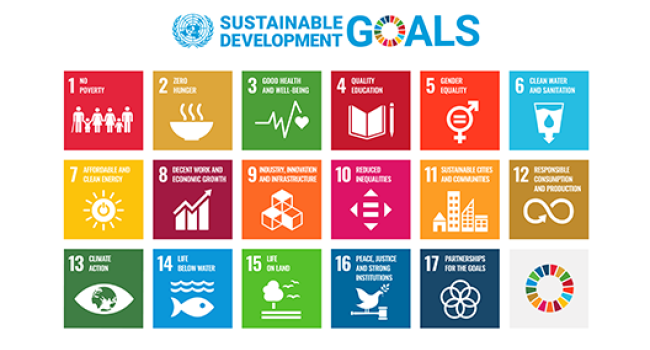
Driving force for lasting change
At Storebrand, we fundamentally believe that investing in companies well-positioned to deliver on the UN’s Sustainable Development Goals (SDGs), will deliver better risk-adjusted long-term returns for our clients. We therefore put capital into action to fund socially beneficial, sustainable solutions aligned with the achievement of the SDGs; and we reduce exposure to activities that impact society and the environment negatively.
Our solutions
-
Storebrand offers a variety of funds all of which are classified as either Article 8 or Article 9 under the EU Sustainable Finance Disclosure Regulation (SFDR), a new set of EU rules for increased comparability and reduced greenwashing among financial products. The regulation will increase the information available for investors about both the potential positive and negative impact of their investments and the related ESG risk.
The SFDR, a crucial part of the EU’s Sustainable Finance Framework and European Green Deal, sets out strict criteria for the classification of funds that define themselves as sustainable. Through proprietary analysis, we identify what we call ”solution companies”. These are companies that help achieve the SDGs through products, services and operations, without causing significant harm. The companies that are categorized as solution companies are included in a database that is updated regularly. The database is a valuable tool for fund managers in their work on sustainable investments and serves as the basis for our thematic solution portfolios (for example, on renewable energy, smart cities and equal opportunities), or as part of broader investment portfolios. At the end of 2021, 13 percent of our equity investments were invested in solution companies.
All of Storebrand’s funds are classified at least within the designation of Article 8. In addition, we offer actively managed Article 9-classified Solution Funds focused on investing in companies that provide solutions, primarily through products and services that are well-positioned to benefit from the identified megatrends within the United Nations Sustainable Development Goals (SDGs). These funds are subject to additional sustainability criteria beyond the basic Storebrand Standard that apply to all our funds.
Storebrand has also launched two new Solution Funds: one focusing on sustainable cities and one focusing on equal opportunities.
-
Storebrand offers a variety of funds with fixed income and balance mandates, that are classified as either Article 8 or Article 9 under the EU Sustainable Finance Disclosure Regulation (SFDR). In addition to adhering to Storebrand Sustainability Policy, the majority of our fixed income funds are defined as fossil-free.
Furthermore, we invest in green bonds, which allow fixed income funds to increase their exposure to projects that are focused on sustainability. The green bonds are for companies that both meet the Storebrand Standard and are in line with international standards such as the Green Bond Principles, the forthcoming EU Green Bond Standard, and with the framework of the International Capital Market Association (ICMA).
By the end of 2021, we had invested NOK 25.7 billion in green bonds. This accounts for 6 per cent of our total bond investments, up from 5 per cent in 2020. One example of our green bond investments is a fund investment we made in the Nordic Investment Bank’s bond, which aims to improve water quality in the Baltic Sea.
Another example is a bond issued by our Green Bond Fund, towards Hybrit, a project that the mining company Luossavaara-Kiirunavaara Aktiebolag (LKAB) is running together with the steel manufacturer SSAB and the power company Vattenfall. Together the companies aim to develop a method for producing steel using hydrogen instead of coal. Today, steelmaking is one of the major carbon dioxide sources globally. This project could completely revolutionize how to produce steel, cement and many other energy-intensive materials.
In 2022, many exciting factors will further strengthen the green bond market. We expect that during the year, both the taxonomy and the EU green bond standard will be concretized by the EU Commission and Parliament. Their stated aim is to create a deeper and more liquid market in EU Green bonds, which in turn will make it easier to invest with sustainability as a priority.
-
We integrate sustainability throughout our real estate business and aim to be the Nordic region’s leading player in sustainable real estate management.
The share of our buildings that were environmentally certified (BREEAM or equivalent) increased from 43 per cent in 2020 to 68 per cent in 2021. We reduced emissions from our real estate investments, from 7.9 kg CO2 per m2 in 2020, to 5.9 CO2 per m2 in 2021. In 2021, three out of four reporting companies with direct real estate investments achieved a 5-star rating from the Global ESG Benchmark for Real Assets (GRESB).
The Danish-based company Capital Investment, which we acquired in 2021, has not yet reported to GRESB, and the properties that the company manages are not included in the figures for certification and greenhouse gas emissions above.
-
Storebrand manages capital for infrastructure investments that enable the transition to a green economy. The transition away from fossil fuels will require significant investment in renewable energy infrastructure, both from the public and private sector.
During 2021, Storebrand Asset Management established and raised capital for a fund that invests in sustainable infrastructure. The main categories of investments include (but are not limited to)
- offshore and onshore wind
- solar
- biomass
- district heating
- power transmission and distribution
- battery storage
- electric transportation
The fund has set up a strategic partnership model, where the deal sourcing, diligence process and day-to-day management of assets is conducted by our carefully selected investment partners.
Throughout the year, the fund made three direct investments in partnership with our main strategic partner, AIP Management: a US onshore wind farm, an offshore wind farm in the UK and 65 electric train sets in the UK. Each investment has a positive sustainability impact.
-
Through Cubera Impact launched in 2021, we now offer a distinct fund-of-fund private equity impact strategy.
The objective is to make positive environmental and social impact while maximizing long-term risk adjusted returns. The offering provides diversified exposure to environmental and social impact to our investors across three main themes:
- sustainable transition
- social inclusion
- disruptive growth

Case study – Smart Cities
Storebrand Smart Cities is a global, fossil-free equity fund aiming to achieve long-term superior returns by investing in companies with business concepts solving social and environmental challenges related to urbanization.
-
Global urban growth engine
Currently, more than half of the world’s population lives in cities already. That number will continue to grow dramatically. By 2050, 70 per cent of the world’s population is expected to live in cities. This bulk of this shift, amounting to 90 per cent of urban expansion, will occur in the developing world.
Tremendous opportunities for social and economic development lie at the heart of this megatrend. Cities are powerhouses of economic growth contributing about 80 per cent of global GDP 1. Historical data suggest that on average, urban populations have higher living standards than in rural areas, and for many, cities provide a way out of poverty.
However, urban areas around the world currently suffer from complex challenges related to quality of life, transportation and pollution, among others. For this megatrend to result in cities that are better to live and work in, much smarter urban planning and more sustainable urban development is needed.
Transformation required
Making cities sustainable means creating career and business opportunities, safe and affordable housing, and building resilient societies and economies. It involves investment in public transport, creating green public spaces, and improving urban planning and management in participatory and inclusive ways.
Significant investment potential
In this context, companies that are deliver products and services for efficient urban planning, seamless transport, better water management, energy-efficient infrastructure and sustainable construction, are well-positioned to grow and thrive. While there are many dimensions to the transformation, three themes in particular stand out that Storebrand Smart Cities is focused on.
The first of these is urban planning, including energy-efficient and functional built environments, which plays a central role to mitigate and adapt to climate change worldwide; to mobility; and to water. Buildings account for almost 40 per cent of energy-related CO2 emissions (2). Green buildings have been graded as the segment with the highest investment potential in cities towards 2030, across all regions worldwide (3). Investment in resilient and energy-efficient buildings can deliver financial savings and reduce GHG emissions.
Another key theme is mobility, a major source of emissions and air pollution. Over 90 per cent of urban inhabitants breathe polluted air of worse quality than WHO’s recommended limit (1). With massive efforts begun, aimed at reversing urban air pollution, investment in clean technology to counteract negative emissions to air will be needed. In 2018, research by the International Finance Corporation’s suggested that the investment opportunity in electric vehicles and public transport combined could amount to USD 2.6 trillion (3).
Water Management is crucial for supplying high quality drinking water, minimising water loss, and adapting to climate change through resilient infrastructure. Climate-smart water systems are estimated to be the third most investable business opportunity worldwide, with a USD 1 trillion opportunity towards 2030.
---------------
Sources:
1) UNDP. (n.d.). Goal 11: Sustainable cities and communities2) World Business Council for Sustainable Development. (n.d.). Driving city scale action for energy efficiency in buildings.
3) International Finance Corporation. (2018). Climate Investment Opportunities in Cities.
-
By focusing on companies with sustainable business models that can help solve these themes, Storebrand can contribute to the fulfilment of the UN SDGs as an integral part of the investment services that we provide to our clients.
Previously, Smart Cities had been available to the Storebrand Group’s pension customers since 2018, but now Storebrand has made the fund available to all.

Case study – Agility Trains East
Investing in sustainable railway infrastructure. Storebrand Infrastructure Fund has, in partnership with AIP, invested EUR 450m in Agility Trains East in the UK.
-
According to the UK Office of Rail and Road (ORR), just 38 per cent of Britain’s railways are electrified. Yet, electric trains have been estimated to emit as much as a third less carbon emissions than diesel ones.
Investment in electrified track and rail fleet infrastructure is therefore critical to meet UK Network Rail’s target of a net zero railway by 2050. The asset consists of a train fleet of 65 electric train sets to replace diesel trains. The trains run from London to Scotland on the East Coast Main Line, a key transport route on the eastern side of the UK.
-
The asset has a strong positive climate impact due to electrification of major train lines in the UK. In addition, it increases passenger capacity to relieve other modes of transport.
Evolving sustainability context
-
One of the important drivers that our strategy depends on, is the European Union (EU) adoption of the Sustainable Finance Action Plan (SFAP), as part of its “European Green Deal”. The goal of this initiative is to promote sustainable investment across and beyond the EU. The SFAP will come into effect in several stages, starting in March 2021.
The EU’s objective is for the union to be carbon-neutral by 2050, and the SFAP is a key part of reaching this goal. For the financial sector, there is a new Sustainable Finance Disclosure Regulation (SFDR) aiming to better classify and streamline the sustainability credentials of investment funds, and a new EU Taxonomy for classification of various economic activities. The taxonomy, which has six environmental objectives, will make it easier for investors to compare financial products promoting environmental characteristics.
The SFAP has three main objectives:
- To reorient capital flows towards sustainable investment and away from sectors with high greenhouse gas emissions
- To manage financial risks stemming from climate change, resource depletion, and environmental degradation
- To foster greater transparency and long-termism in financial and economic activity in order to achieve sustainable and inclusive growth
The EU’s Sustainable Finance Action Plan is relevant for asset managers, pension funds, banks and insurers, among others. There will also be sustainability indices developed for better benchmarking and comparability of investment strategies and funds.
-
The EU Sustainable Finance Disclosure Regulation (SFDR) is a new set of EU rules for increased comparability and reduced greenwashing among financial products. The regulation will increase the information available for investors about both the potential positive and negative impact of their investments and the related ESG risk.
The new disclosure regulation is, together with the above-mentioned Sustainable Action Finance Plan a crucial part of the EU’s Sustainable Finance Framework and European Green Deal. The SFDR sets out strict criteria for the classification of funds that defines itself as sustainable. These criteria are described in the regulation’s Articles 6, 8 and 9.
- Article 9 funds, also known as ‘products targeting sustainable investments’, covers products targeting bespoke sustainable investments and applies “… where a financial product has sustainable investment as its objective.”
- Article 8 funds, also known as environmentally and socially promoting’, applies “… where a financial product promotes, among other characteristics, environmental or social characteristics, or a combination of those characteristics, provided that the companies in which the investments are made follow good governance practices.”
- Article 6 covers funds that are not Article 8 or 9. However, sustainability may still be part of the portfolio manager’s process, e.g. by assessing the sustainability risk. This category covers all other products and consequently includes everything from funds that report sustainability as not relevant, to funds that have good integrations of sustainability, but which are not defined as such by the SFDR (for example, an index fund that excludes the worst companies from an ESG perspective).
Tools and resources
-
Since 2012, Storebrand has developed and integrated a sustainability score providing a foundation for investment decisions, by ranking the companies on operations, products, and services. In this way, we can effectively identify companies that have the potential to deliver good returns, while helping to solve sustainability challenges.
The score is comprised of two main building blocks: ESG risks and SDG opportunities.
On the ESG risk side, the score assesses companies’ exposure to, and management of, financially material sustainability risks.
On the SDG opportunities side, we analyse sustainability data sources and use internal research on solution companies to find companies whose products and services contribute positively to the achievement of financially relevant SDGs.
The Sustainability Score is relevant across asset classes. Portfolio managers at Storebrand Asset Management can access the score on several levels. Total Score, Risk Score, SDG Score, and scores for underlying themes within these building blocks, are all readily available.
The data sources underpinning the scores are external sources from quality-controlled data providers, coupled with internal research. We currently use the following providers:
- ESG Risks: Sustainalytics ESG Risk Rating (50%)
- SDG Opportunities - Products & Services: FTSE Russell Green Revenue Streams plus internal research (40%)
- SDG Opportunities - Operations: Equileap data on Gender Equality (10%)
Implementation of the score is dependent on the style and risk profile of the fund/portfolio in question. The score can be used to better assess the ESG risk of a particular investment, for identifying companies with an attractive SDG positioning, or for assessing the overall exposure on ESG risk and opportunities of a portfolio. Implementation is dependent on the style and risk profile of the fund/portfolio in question. In addition, the score is used to optimise portfolios towards better-performing companies and to calculate an internal fund rating.
-
Through analysis, Storebrand Asset Management identifies what we classify as ”Solution companies” - ones with business models that contribute to achieving the SDGs through their products and services, without causing significant harm. Solution company investments are one of several ways that we help shift capital towards alignment with the Paris Agreement, in particular paragraph 2.1.c): ”Making finance flows consistent with a pathway towards low greenhouse gas emissions and climate-resilient development” and the SDGs, including social and climate solutions. A solution company should be compliant with the EU Taxonomy on Sustainable Finance if it is eligible for the classification system on sustainable business activities.
We assemble these identified companies into a ”Solutions database” that is available for fund managers in their research for investment ideas. The research and identification of solution companies is information that is also fed back to and represented in the sustainability score, ensuring an important feedback loop of information being made available to portfolio managers.
Our Solutions database also serves as a basis for our thematic portfolios, i.e., on climate solutions or smart cities, both as part of a larger investment portfolio or as thematic investment products. SAM provides broader solutions-oriented investment products, investing across the themes we have defined to be material, to achieve the overall ambition of the UN Sustainable Development Goals.
How we rate our funds
Our Fund Sustainability Score, ranging from 1-10, is based on an underlying Company Sustainability Score.
